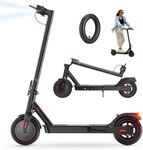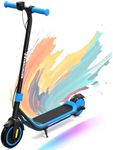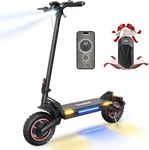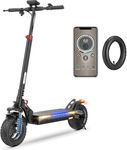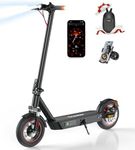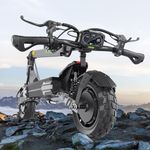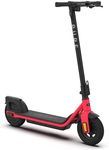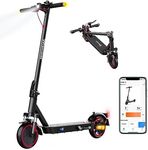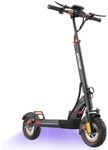Buying Guide for the Best Electric Scooter
Choosing the right electric scooter involves understanding your needs and matching them with the right specifications. Electric scooters come in various models with different features, so it's important to know what to look for to ensure you get the best fit for your lifestyle. Consider where and how often you'll be using the scooter, as well as any specific requirements you might have, such as portability or speed. Here are some key specifications to consider when selecting an electric scooter.Battery LifeBattery life determines how far you can travel on a single charge. This is crucial if you plan to use your scooter for long commutes or extended rides. Battery life is usually measured in miles or kilometers. Short-range scooters (up to 10 miles) are suitable for quick trips and short commutes. Mid-range scooters (10-20 miles) are good for moderate daily use, while long-range scooters (20+ miles) are ideal for longer commutes and extensive use. Consider your daily travel distance to choose the right battery life for your needs.
Motor PowerMotor power affects the scooter's speed and ability to handle inclines. It's measured in watts (W). Lower power motors (up to 250W) are suitable for flat terrains and lighter riders. Mid-range motors (250W-500W) offer a balance of speed and power, making them good for moderate hills and average weight riders. High power motors (500W+) are best for steep hills and heavier riders. Think about the terrain you'll be riding on and your weight to determine the appropriate motor power.
Top SpeedTop speed indicates how fast the scooter can go. This is important if you need to keep up with traffic or prefer a quicker ride. Speeds typically range from 10 mph to 30 mph. Lower speeds (up to 15 mph) are safer and suitable for beginners or those riding in pedestrian areas. Mid-range speeds (15-25 mph) are good for urban commuting. Higher speeds (25+ mph) are for experienced riders who need to travel quickly. Consider your comfort level and the speed limits of your riding areas.
Weight and PortabilityThe weight of the scooter affects its portability. If you need to carry your scooter on public transport or store it in small spaces, a lighter model is preferable. Lightweight scooters (under 25 lbs) are easy to carry but may have fewer features. Mid-weight scooters (25-40 lbs) offer a balance of portability and performance. Heavy scooters (40+ lbs) are more robust and feature-rich but harder to carry. Think about how often you'll need to lift or transport your scooter to choose the right weight.
Wheel Size and TypeWheel size and type impact the ride quality and ability to handle different terrains. Smaller wheels (under 8 inches) are more portable but less stable on rough surfaces. Medium wheels (8-10 inches) offer a good balance of stability and portability. Larger wheels (10+ inches) provide a smoother ride on uneven terrain. Solid tires are puncture-proof but offer less shock absorption, while air-filled tires provide better cushioning but can get flats. Consider the surfaces you'll be riding on to choose the right wheels.
Braking SystemThe braking system is crucial for safety. There are different types of brakes, including foot brakes, drum brakes, disc brakes, and electronic brakes. Foot brakes are simple and found on basic models. Drum brakes are low maintenance and work well in all conditions. Disc brakes offer strong stopping power and are good for high speeds. Electronic brakes are easy to use but less effective on their own. For the best safety, look for scooters with a combination of braking systems. Consider your riding speed and environment to choose the right brakes.
SuspensionSuspension systems improve ride comfort by absorbing shocks from bumps and rough terrain. Scooters can have front, rear, or full suspension. No suspension is fine for smooth, flat surfaces. Front or rear suspension provides some comfort on slightly rough roads. Full suspension offers the best comfort for uneven and bumpy rides. If you plan to ride on varied terrains, a scooter with good suspension will make your rides more comfortable.
Build Quality and MaterialsBuild quality and materials affect the durability and longevity of the scooter. Scooters made from high-quality materials like aluminum or carbon fiber are lightweight yet strong. Plastic components can reduce weight but may not be as durable. Look for a sturdy frame and quality components to ensure your scooter can withstand regular use. Consider how often you'll use the scooter and the conditions it will face to choose the right build quality.
